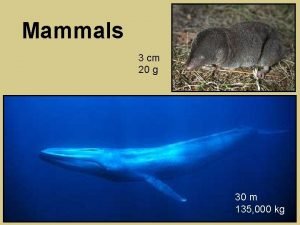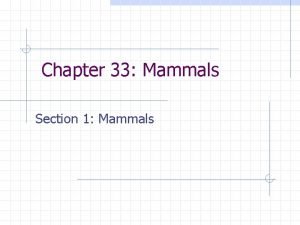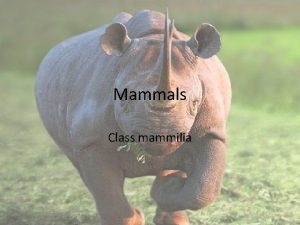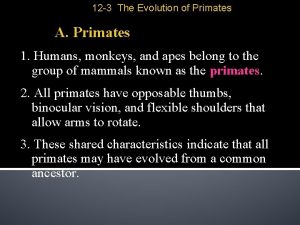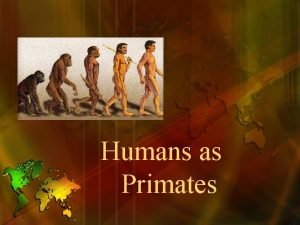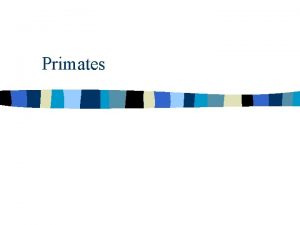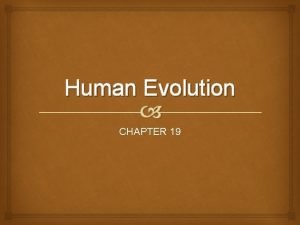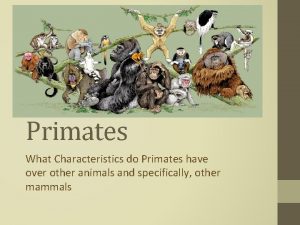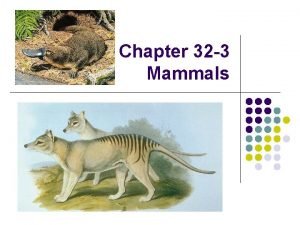Closer look at primates Mammals called primates include























- Slides: 23

Closer look at primates • Mammals called primates include Lemurs, monkeys, apes, humans. • 300 species of primates living today • Evolved from a small tree dwelling, insect eating ancestor 65 million years ago.

Primate characteristics • Although primates live on the ground, they retain adaptations for living on trees. a) Flexible shoulder joints (swinging). b) Sensitive fingers/nails instead of claws. c) Hands can hang and manipulate food. d) Binocular vision: Eyes in front of the face and the field of vision overlap enhancing depth perception.

Primates divided into 2 major groups • Strepsirrhini: wet-nosed • Haplorhini: dry-nosed

Strepsirrhini • Includes lorises, galagos, and lemurs. • Lemurs (Madagascar) • Lorises (Africa and South Asia) • They are mostly nocturnal, tree dwellers and have claws.

Haplorhini • Includes tarsiers, new world monkeys, old world monkeys, apes and humans. • Tarsiers (South East Asia) • New Word Monkeys: (Americas) Tree dwellers, prehensile (grasping) tails for swinging. • Old World Monkey: Tree dwellers but tails are not prehensile, include baboons, macaques, and mandrills.

Chimpanzees • Use Tools • Biologically the closest relatives of humans; differing in about 5% of their DNA sequence.

Apes vs. Humans Think about some differences Think about some similarities

Communicate

Work together

Sometimes even walk ‘upright’

Early Hominids • Mammals that are more closely related to humans than to any other species family are called hominids (family Hominidae, Order Primates). • Today, only 1 species of hominids exist: Homo sapiens (modern humans). • Earliest man may have lived 6 to 7 million years ago.


1. Which hominid species was in existence 5 million years ago? 2. Which hominid species were in existence when Homo habilis was alive? ?

Important Developments • Walking Upright • Enlarged Brains

Important Developments WALKING UPRIGHT: Australepithecus aferensis provides the oldest evidence of upright posture and BIPEDALISM; walking on 2 feet. • Lucy, female, 3. 5 feet tall, head the size of a softball was the first to walk on 2 feet.

Important Developments ENLARGED BRAINS: First appeared in East Asia 2. 5 million years ago. • Large brains found with tools; Homo habilis. • Increase in intelligence gave them success in Africa.

• By comparing skulls, scientists can trace the evolution of the enlarged brain through hominid history.

Important Developments • Human brains are much bigger than our ancestors’ • Our brain size is about 1400 cm 3 • Our earliest ancestors had brains that were only about 400 cm 3

Hypotheses for Origin of Modern Man MULTIREGIONAL HYPOTHESIS: • Fully modern human developed from H. erectus descendants that spread from Africa 1. 5 million years ago. • Interbreeding among regional H. sapiens evolved as a single species.

Hypotheses for Origin of Modern Man REPLACEMENT HYPOTHESIS: • All regional H. erectus became extinct in the world. • Humans descended from a group of H. erectus that remained in Africa. They started spreading out 100, 000 years after replacing the other.



• http: //www. youtube. com/watch? v=441 r. RHO Hx 5 c • EVOLUTION: THE EVOLUTION OF HUMANS DOCUMENTARY 2014. . 45 min • http: //www. youtube. com/watch? v=Vv 3 I 22 js. U Ew NEANDERTHALS. . 50 min • http: //www. youtube. com/watch? v=rohhwn 1 1 xe. I DECODING NEANDERTHALS. . 50 min
 Look up to the left
Look up to the left Pelycosaurs
Pelycosaurs Invertebrates classification
Invertebrates classification #include stdio.h #include conio.h #include stdlib.h
#include stdio.h #include conio.h #include stdlib.h Include stdlib
Include stdlib #include stdio.h #include stdlib.h #include string.h
#include stdio.h #include stdlib.h #include string.h Look closer see me
Look closer see me Chapter 7 a closer look energy metabolism pathways
Chapter 7 a closer look energy metabolism pathways Chapter 7 a closer look energy metabolism pathways
Chapter 7 a closer look energy metabolism pathways A closer look at thanksgiving
A closer look at thanksgiving Meiosis prophase 2
Meiosis prophase 2 Namespace string
Namespace string #include iostream #include cmath
#include iostream #include cmath Que es #include iostream
Que es #include iostream C++ include iostream
C++ include iostream #include iostream using namespace std
#include iostream using namespace std Include string.h
Include string.h Include namespace std
Include namespace std #include iostream using namespace std
#include iostream using namespace std Include iostream
Include iostream #include stdio.h int main()
#include stdio.h int main()

